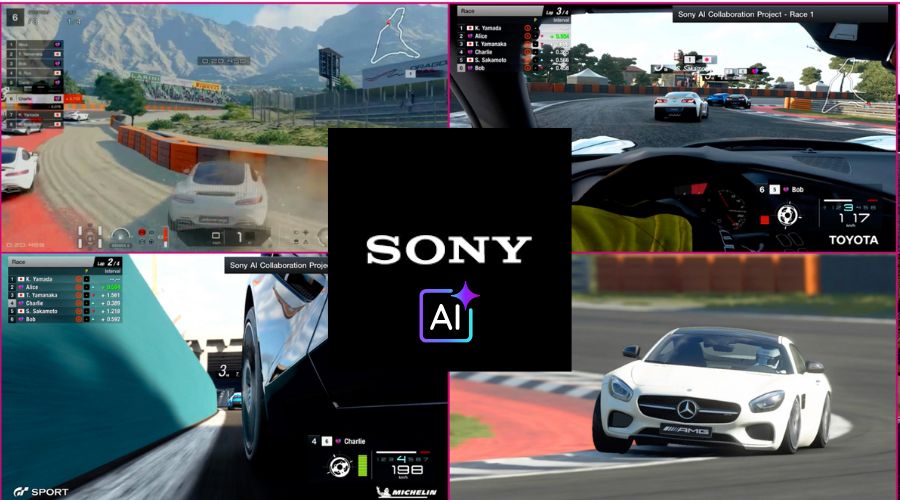Back in 2020, Sony AI decided to tackle something pretty audacious: build an AI that could actually beat the world’s best Gran Turismo drivers. Not just compete with them, beat them. By 2021, they’d pulled it off. But that breakthrough was really just the opening move in Sony’s much bigger AI vision for gaming.
Sony’s positioned itself at the forefront of gaming’s AI revolution. Their approach is interesting because it’s not about replacing human creativity they’re pretty insistent on that point. Instead, they’re leveraging machine learning across multiple areas: racing agents that learn like humans do, AI-powered upscaling tech, next-gen console architecture, and intelligent game development tools. Let’s dig into what Sony Gaming AI actually is, how the technology works, and what it might mean for developers and players.
What is Sony Gaming AI?
Sony Gaming AI is a comprehensive ecosystem of AI technologies meant to enhance every aspect of interactive entertainment. Unlike traditional rule-based game AI that follows predetermined scripts, Sony’s approach uses something called deep reinforcement learning to create adaptive AI agents that actually learn through experience, much like humans do.
At its core, Sony’s AI philosophy is straightforward: AI should augment creativity, not replace it. That principle guides everything from how their 50,000+ employees across 210 teams use the company’s Enterprise LLM platform to how AI gets integrated into PlayStation consoles and games.
The company works with teams focused on legal, privacy, and ethics to establish clear guidelines for AI usage. They’re particularly concerned about preventing unauthorized content reproduction. Sony also uses AI to protect creators’ work by building systems that can detect stolen or improperly used content.
Sony’s AI Approach: Beyond Rule-Based Systems
Traditional game AI operates on rigid rules: “If player does X, then NPC does Y.” It’s predictable. Sony’s transforming Game-AI by using deep reinforcement learning to train AI agents in gaming ecosystems. This technology enables developers to design and deliver richer experiences that can adapt, learn, and evolve.
How reinforcement learning works in games
Reinforcement learning (RL) agents learn tasks through repeated practice in an environment. Think of it like teaching someone to drive: they practice over and over, get feedback on their actions, and gradually improve through trial and error.
Sony AI’s approach rewards positive behaviors and punishes undesired actions, which allows the AI to continuously improve through iterative training. Modern video games, with their need for precise control and creative solutions, provide ideal training grounds for these agents. The innovations developed for gaming may also apply to other real-world domains.
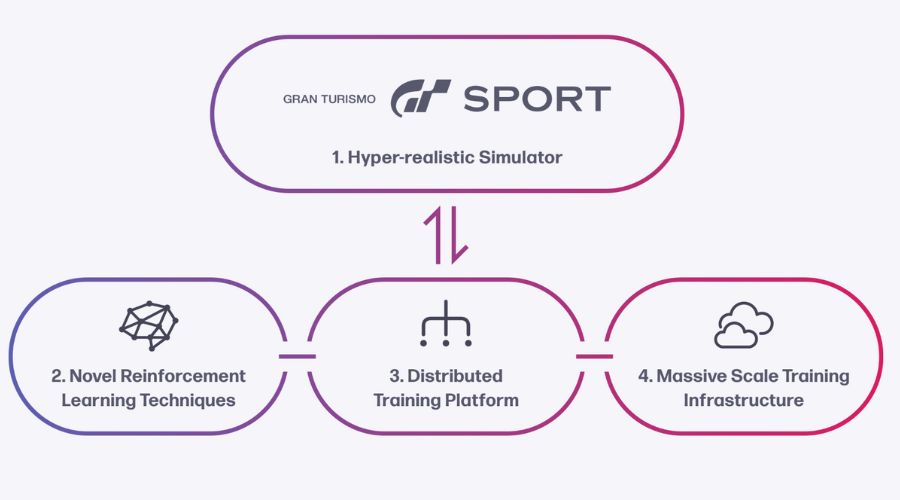
Gran Turismo Sophy: The Breakthrough AI Racing Agent
Racing AI explained
Gran Turismo Sophy (GT Sophy) represents Sony’s most celebrated AI achievement. An autonomous racing agent that doesn’t just compete with the world’s best Gran Turismo drivers but actually beats them while demonstrating remarkably human-like racecraft.
It came out of a unique collaboration between Sony AI, Polyphony Digital, and Sony Interactive Entertainment. GT Sophy achieved what many thought was impossible: superhuman racing performance combined with genuine sportsmanship.
The achievement earned recognition as a cover article in Nature in February 2022. It also won Sony AI the 2022 ACM SIGAI Industry Award for Excellence in Artificial Intelligence.
How GT Sophy learns to race
GT Sophy learns racing the same way professional drivers do: through extensive practice. The AI drives cars thousands of times on each track, racing against other vehicles to master proper on-track behavior and racecraft.
Rather than following pre-programmed racing lines, GT Sophy uses reinforcement learning to develop intuitive understanding:
- Contemplates overtaking opportunities rather than just executing scripted maneuvers
- Exhibits restraint when aggressive moves might cause accidents
- Adapts racing lines based on opponent positioning and race conditions
- Balances competitive drive with clean racing practices learned through reinforcement
This adaptive strategy produces racing behavior that feels genuinely human rather than mechanical. GT Sophy doesn’t just follow the optimal path—it makes real-time strategic decisions based on how the race is evolving.

Emotional intelligence on the track
Perhaps GT Sophy’s most remarkable feature is its emotional dimension. The AI uses visual “emojis” displayed above its car to communicate emotional state during races:
- Shows “sadness” when crashed into or overtaken
- Displays “happiness” when executing successful passes
- Audible chimes signal emotion changes
This reflects GT Sophy’s sophisticated understanding of racing psychology and competitive dynamics. It helps players connect with the AI as a racing opponent rather than just an algorithm.
Benefits of GT Sophy for players
Flexible training partner
The March 2025 release of GT Sophy 2.1 transformed the AI from a superhuman opponent into customizable training partner. Players now have unprecedented control over their racing experience:
- Choose from 19 car models and tracks
- Select number of laps and racing conditions
- Customize GT Sophy’s vehicles with upgrades and tuning specs
- Set tire and fuel consumption rates
- Adjust difficulty to match personal skill level
Enhanced racing skills
GT Sophy helps players advance their racing abilities by:
- Providing consistent, adaptive competition at any skill level
- Demonstrating proper racing etiquette and sportsmanship
- Creating opportunities to experiment with new strategies
- Offering challenging opponents that respond realistically to player tactics
Richer gaming experiences
GT Sophy demonstrates that AI can create more engaging, dynamic gameplay. Rather than predictable opponents that players quickly learn to exploit, GT Sophy continually adapts, making every race feel fresh and competitive.
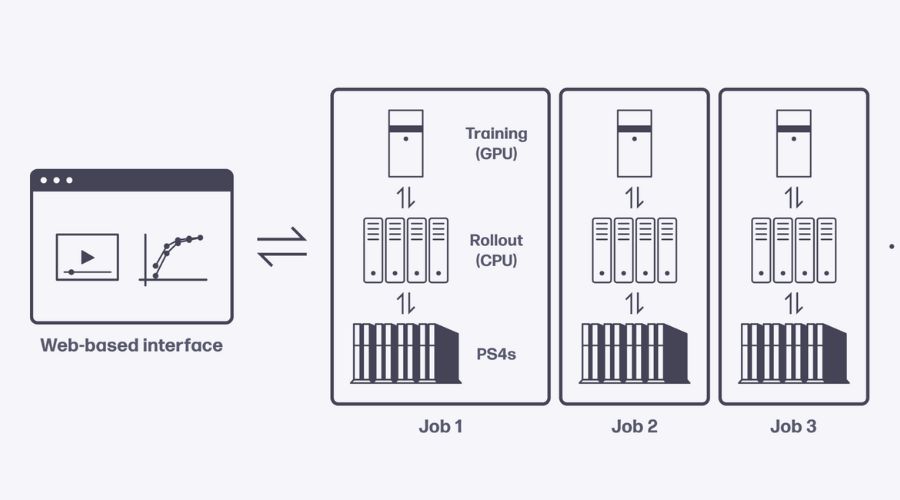
The Technology Behind GT Sophy
Multi-agent learning
Almost all video games involve dealing with other agents or humans, and the rules of engagement often aren’t formalized. Without well-specified cost functions or access to all possible behaviors, AI agents in games need to be more robust and tunable than in traditional AI domains.
GT Sophy interacts simultaneously with multiple agents and human players, learning to navigate complex social dynamics on the track. Since almost all real-world domains involve multiple agents—such as autonomous vehicles and robotics—the multi-agent learning techniques Sony developed for GT Sophy could apply broadly beyond gaming.
Scalable training infrastructure
Modern reinforcement learning and AI algorithms require massive compute and data resources. Sony AI developed a sophisticated engineering ecosystem that enables:
- Large-scale compute resources for modern RL algorithms
- Rapid deployment of learning algorithms trained on video games at scale
- Trustworthy and repeatable RL processes for production environments
- Efficient training of AI agents across diverse gaming scenarios
This platform represents years of research into constructing engineering ecosystems specifically designed for game AI training, and continues to evolve to support increasingly sophisticated AI applications.
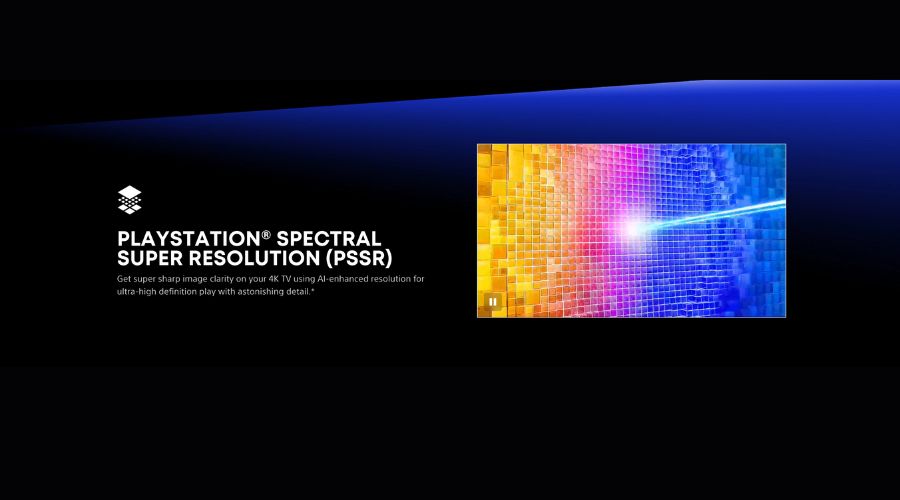
PlayStation Spectral Super Resolution (PSSR): AI-Powered Upscaling
What is PSSR?
PlayStation Spectral Super Resolution (PSSR) is Sony’s AI rendering technology powered by dedicated machine learning processors on the PS5 Pro. Debuting in November 2024, PSSR represents the first machine learning upscaler implemented on home consoles, bringing technology that was previously exclusive to high-end PC gaming to mainstream audiences.
Similar to NVIDIA’s DLSS (deep learning super sampling) technology, PSSR taps into neural networks trained with high-resolution images. Machine learning teaches the network how to add in and infer details about images, creating sharp visuals from lower-resolution renders.
PSSR explained
PSSR allows games to render at lower resolutions such as 1080p Full HD or 1440p Quad HD, then uses AI algorithms to determine what those images would look like if they were actually rendered at higher resolutions like 2160p or 4K.
Images are rendered at lower resolutions but give the impression they’re running at much higher resolutions. This dramatically reduces the work that graphics processing units (GPUs) have to do, resulting in increased graphics performance and frame rates while producing sharp images that go beyond native rendering capabilities.
Mike Fitzgerald from Insomniac Games explains: “We can render at a lower resolution, bring it up to a full 4K, and get tons of extra detail out of the picture.”
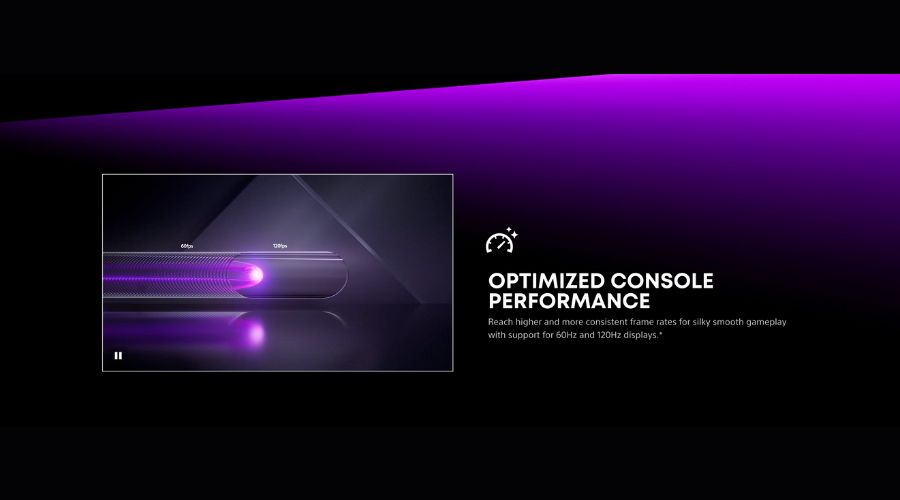
How PSSR learns and improves
What distinguishes PSSR from traditional upscaling is its learning capability. Travis McIntosh from Naughty Dog highlights this: “[PSSR] produces just a way better result than previous upscalers because it can be trained not only on our game but on plenty of other games, and it learns and it improves at each iteration.”
The neural network behind PSSR trains across multiple games rather than being optimized for single titles. This cross-game learning enables PSSR to:
- Fix graphical errors and artifacting automatically
- Improve challenging elements like foliage rendering through specialized training
- Deliver better results over time as more developers implement the technology
- Adapt to various art styles and visual approaches
As the neural network continues learning, the algorithm powering the technology improves, benefiting both developers integrating PSSR and gamers experiencing enhanced imagery.
Benefits of PSSR for Gamers and developers
Faster frame rates
Games that run at higher frames per second (fps) generally perform better and faster, though the desired FPS varies depending on gaming requirements. Most games perform ideally with at least 30 fps, while action-packed titles typically target 60 fps or beyond.
PSSR can accelerate frame rates substantially by enabling 4K visual quality while rendering at less demanding resolutions, freeing up GPU resources for higher performance.
Enhanced images
Running games at higher fps can affect visuals, causing stuttering or lagging. PSSR helps counteract this, delivering enhanced and sharper image quality comparable to what you’d expect at higher native resolutions.
For instance, PSSR offers the extra pixels and visual output of 2160p (4K) imagery while actually rendering frames at lower-powered 1080p resolution, maintaining visual fidelity without the performance cost.
Improved performance
Games running at higher settings can significantly tax graphics cards and hurt performance. Performance varies depending on whether GPUs are running ray tracing, the specific game being played, and hardware configurations.
PSSR helps improve system performance even when running at higher settings by efficiently using machine learning processors to deliver dramatically better results than previous console upscaling methods.
PSSR vs. competing technologies
Digital Foundry conducted extensive testing comparing PSSR against competing upscaling technologies using Ratchet & Clank: Rift Apart, matching resolutions precisely to ensure accurate comparison between PSSR, AMD FSR 3.1, and NVIDIA DLSS 3.7.
Results:
- PSSR significantly outperforms traditional console upscaling
- Approaches DLSS quality in many scenarios
- Particularly strong with complex visual elements and edge detail
For console gamers, PSSR represents a generational leap in visual quality without requiring proportional increases in GPU power, democratizing technology that was previously available only to PC gamers with expensive graphics cards.
Project Amethyst: The Future of PlayStation Gaming
Sony and AMD’s next-generation collaboration
Project Amethyst represents a significant gaming technology partnership between Sony and AMD aimed at defining graphics architecture for PlayStation 6 and beyond. Development began in 2023 when PS5 Pro was largely complete, with the explicit goal of using AI and machine learning to improve game visuals and performance.
The codename Amethyst combines PlayStation blue with AMD red, creating purple—a symbol of their unified vision for gaming’s future.
Mark Cerny’s vision for machine learning gaming
Mark Cerny, lead architect for PS5 and PS5 Pro, states: “Machine learning-based processing is the future.” The goal is “fewer pixels, prettier pixels coupled with machine learning libraries to increase resolution or add frames or assist in various ways with ray tracing.”
This represents a fundamental shift in gaming hardware philosophy, prioritizing intelligent processing over brute computational force.
Three Pillars of Project Amethyst
1. Neural Arrays (Performance)
Neural Arrays represent a collection of compute units connected to function as a single, focused AI engine. They’re designed to be more efficient for large machine learning workloads than traditional GPU designs, enabling next-generation neural rendering with dedicated hardware for AI upscaling, frame generation, and ray tracing enhancement that reduces computational burden on standard GPU cores.
2. Radiance Cores (Immersion)
Dedicated ray traversal hardware designed for high-performance real-time ray tracing and path tracing. Radiance Cores offload intensive ray tracing tasks from shader cores, freeing them to work on other scene elements while delivering higher fps with immersive visuals. This makes photorealistic lighting and reflections computationally feasible for consoles, bringing visual quality previously limited to expensive PC setups to mainstream gaming.
3. Universal Compression (Efficiency)
A compression system that evaluates and compresses all available data within the GPU, not just textures. This dramatically reduces memory bandwidth usage, enabling new performance levels with greater efficiency. It addresses a critical bottleneck in modern GPU design.
Timeline and availability
AMD’s Jack Huynh revealed that the machine learning acceleration hardware they’re co-engineering on RDNA 5 directly results from the Sony collaboration. This technology will appear in:
- RDNA 5 graphics cards: First public confirmation of AMD’s next GPU generation
- 2026-2027 launch window: Expected timeframe for next-generation consoles
- Cross-platform benefit: Technologies appearing in both PlayStation 6 and AMD Radeon graphics cards
FSR Redstone: Shared AI upscaling innovation
Sony and AMD co-developed a new AI upscaling algorithm that serves as the foundation for AMD’s FSR Redstone, announced at Computex 2025. The algorithm shifts from Convolutional Neural Networks (CNN) to Transformer Model architecture, designed to create sharper upscaled images than current generation technology.
Mark Cerny emphasizes interoperability: “There will be implementations of the algorithm as FSR and implementations of the algorithm as Spectral… But the fact is they will be extraordinarily close because we want the game developers to have interoperability.”
This approach benefits developers who can implement similar AI upscaling across PC and console platforms without significant additional work, while gamers enjoy consistent quality regardless of hardware.
Frame generation coming to consoles
Project Amethyst’s next phase includes machine learning-based virtual frame generation—technology currently available on PC coming to PS5 Pro and future consoles. AI creates entirely new frames that get inserted between rendered frames, dramatically increasing frame rates without proportional GPU load.
Cerny emphasizes player choice in this implementation: “We can support a high frame rate by having a lower resolution render and more aggressive super resolution. We can also support a high frame rate by using frame generation. And once that choice is out there, Sony can learn more about what gamers want.”
AI in Game Development: Sony’s Internal Tools
AI-powered quality assurance
Sony has pioneered machine learning-based game testing that dramatically improves QA efficiency and accuracy, addressing growing concerns about testing costs as games become larger and more complex.
Dual agent QA system
Sony developed two complementary AI agents for automated testing:
Replay Agent excels at replicating exact button combinations. It can navigate in-game UI and PS5 hardware menus, move characters from spawn points to level transitions, and test scenarios requiring perfect consistency.
Imitation Agent introduces variability reflecting real-world gameplay. It reproduces human-like play patterns with natural variance, uses machine learning models trained on human gameplay data, and adapts to dynamic game elements like enemy AI and camera control.
Case study: Astro’s Playroom
Sony showcased their AI QA system through Astro’s Playroom development. Human testers played each section 10-20 times to create representative samples. Machine learning models learned from this gameplay data, after which AI agents autonomously tested game sections.
Benefits achieved:
- Significantly reduced testing time in many scenarios
- Earlier bug detection throughout the development cycle
- Improved overall game quality at release
Limitations:
- Some games require extensive training data for effective testing
- Changes in game parameters necessitate new ML models
- System still requires human oversight
Human-equivalent gameplay automation
At CEDEC 2024, Sony presented AI technology enabling autonomous gameplay on PS5 that replicates human-player conditions. The system uses only on-screen information, combining imitation learning, controller operation recording/replay, and image recognition with model switching based on visual cues.
This automates PS5 system software function tests under end-user conditions, reducing QA costs and identifying defects earlier in development—critical as testing demands grow alongside game complexity.
Additional AI Innovations
Predictive AI: Anticipating player actions
Sony filed a patent revealing AI capable of predicting players’ next button press before it happens. The technology uses cameras to monitor player movements during gameplay, with AI learning to recognize patterns and predict upcoming inputs based on physical movements.
Potential benefits:
- Eliminates input lag by anticipating actions before execution
- Provides competitive advantages through split-second timing improvements
- Seamlessly handles internet disruptions by automatically completing interrupted commands
The predictive assistance system suggests dedicated AI processors (Neural Processing Units) in future PlayStation consoles, potentially enabling accelerated ray tracing, improved performance modes, and real-time strategic tips offered adaptively during gameplay.
AI-powered NPCs: Interactive Aloy prototype
Sony’s Advanced Technology Group created an AI-powered version of Aloy from Horizon Forbidden West that demonstrates conversational AI in gaming. The prototype combines OpenAI Whisper (speech-to-text), GPT-4 and Llama 3 (dialogue and decisions), Sony’s Voice Synthesis system, and Sony’s Mockingbird technology (audio-to-facial animation).
The demonstration showcased Aloy responding to player voice prompts with AI-generated voice and realistic facial expressions, all tested on PS5 consoles with minimal performance impact. While it remains an internal prototype not confirmed for public release, it demonstrates possibilities for NPCs engaging in natural language conversations, characters adapting dialogue based on player history, and voice interactions replacing traditional dialogue trees.
Content protection and enhancement
Sony uses AI to safeguard intellectual property through systems that detect if content has been stolen or improperly used and monitor for unauthorized reproduction. AI applications also extend to media enhancement, including legacy content restoration and PS5 picture quality improvements.

Supported Hardware and Future Integration
PSSR-supported consoles
PSSR is available on the PlayStation 5 Pro, released in November 2024. The technology leverages dedicated machine learning processors integrated into the console’s custom GPU architecture, enabling AI upscaling across all games that implement the feature.
Expected features in PlayStation 6
Mark Cerny’s statement that “machine learning-based processing is the future” indicates AI will play a major role in next-generation consoles:
AI-native architecture: RDNA 5 GPU with dedicated neural processing units, Project Amethyst technologies (Neural Arrays, Radiance Cores, Universal Compression), and hardware designed for AI workloads from the ground up.
Advanced upscaling and frame generation: Evolution of PSSR with improved algorithms, AI-generated frames boosting performance, and real-time ray tracing enhancement through machine learning.
Developer flexibility: Support for various AI models including ChatGPT (if developers choose), interoperability between AMD FSR and PlayStation Spectral upscaling, and libraries focused on maximizing hardware capabilities.
Player choice: Options between aggressive upscaling or frame generation for high frame rates, customizable AI assistant features, and adaptive difficulty through AI analysis.
Games and Engines Supporting Sony AI Technologies
GT Sophy availability
Gran Turismo Sophy 2.1 is available in Gran Turismo 7’s Custom Race mode, offering players unprecedented customization and control over their AI racing experiences.
PSSR-enabled games
An expanding library of games supports PSSR on PS5 Pro. Major titles from Sony’s first-party studios and third-party developers are implementing the technology. As more developers adopt PSSR, the neural network continues learning and improving, benefiting all games that use the upscaling system.
Sony AI: Mission and Responsible AI Principles
Organizational mission
Sony AI was established in April 2020 to pursue research in AI and robotics within entertainment. Their mission statement captures the philosophy: “Unleash Human Imagination and Creativity with AI.”
Working with artists, makers, and creators worldwide, Sony AI focuses on six strategic challenges, including developing trustworthy sensing platforms, transforming digital environment interactions, leading with ethical AI, and discovering where AI inspires unprecedented creativity.
Core values
Sony has articulated clear principles governing AI development:
- AI should augment human creativity, not replace it
- Ethical considerations must guide AI implementation
- Privacy and legal compliance are essential
- Creators’ intellectual property must be protected
- Transparency about AI benefits and limitations is necessary
The Future of Sony’s AI-Powered Gaming Vision
When Sony Gaming AI technologies were first developed, each application required separate training and implementation. Now, with projects like PSSR and the cross-platform FSR Redstone collaboration, Sony offers more generalized AI networks that work across multiple games and platforms.
As neural networks behind Sony’s AI technologies continue learning, the algorithms powering them improve as well. This benefits developers implementing these technologies in their games and gamers experiencing faster frame rates, enhanced imagery, richer AI interactions, and more immersive gaming experiences.
Sony’s comprehensive AI strategy positions the company as a leader in gaming innovation across multiple dimensions, from breakthrough achievements like Gran Turismo Sophy to practical applications in upscaling and quality assurance. The company’s investments represent more than incremental improvements—they signal a fundamental reimagining of how games are created, played, and experienced.
From AI racing agents that demonstrate superhuman skill while maintaining sportsmanship to upscaling technologies that deliver 4K visuals without 4K rendering costs, Sony’s building an AI-powered gaming future that balances:
- Technological excellence: Best-in-class AI implementations pushing boundaries
- Human creativity: AI as an augmentation tool, not a replacement
- Ethical responsibility: Clear governance protecting creators and users
- Player enjoyment: Technology serving gameplay
The next generation of gaming isn’t just about more powerful hardware—it’s about smarter hardware that learns, adapts, and enhances every aspect of the gaming experience. With technologies spanning into the late 2020s and partnerships defining future console architecture, Sony isn’t just participating in gaming’s AI-powered future; they’re actively shaping it.
About the Author
This article explores Sony’s comprehensive approach to artificial intelligence in gaming, examining breakthrough technologies like Gran Turismo Sophy, PlayStation Spectral Super Resolution, and Project Amethyst that are reshaping interactive entertainment for the next generation.
